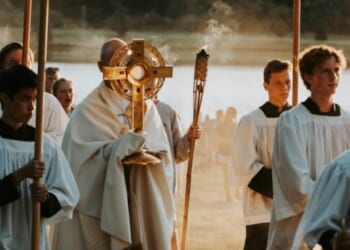Mission: Impossible—The Final Reckoning received US military support, including aircraft carriers and helicopters, for key scenes. The collaboration ensured authenticity, while the film grossed $77 million on opening weekend.
Hollywood mega-star Tom Cruise had a perfect holiday weekend.
His latest film, Mission: Impossible—The Final Reckoning, reportedly the last in the series, grossed $77 million at the box office, marking the top debut for the 29-year-old franchise, based on the long-running TV show. The only thing Cruise and his Impossible Mission team couldn’t defeat was Disney’s live-action Lilo and Stitch remake.
The kid-friendly film brought in $183 million through the long holiday weekend, surpassing even Cruise’s 2022 smash hit Top Gun: Maverick, which featured the Darkstar 72 and tallied $160 million over its opening four-day release window.
The Final Mission Impossible Had DoD Support
Past Mission: Impossible films have been noted for their impressive stunts, many of which were performed by Cruise. However, for what could be the final outing, the production received assistance from the US Department of Defense (DoD), which provided access to real-world assets.
That included the USS George H.W. Bush, with filming allowed onboard while the Nimitz-class nuclear-powered aircraft carrier operated in the Adriatic Sea. According to the Pentagon, the warship “played the most prominent role of all military assets in the filming, hosting the movie’s cast and crew for a few days in late winter 2023, as the ship neared the end of its six-month deployment off the coast of Italy.”
It wasn’t the first time Cruise had been on a carrier, having filmed on the USS Enterprise for 1986’s Top Gun and on the USS Theodore Roosevelt for the sequel. Aerial shots and flight deck sequences were also filmed on the USS Abraham Lincoln.
For Mission: Impossible—The Final Reckoning, scenes were shot on the navigation bridge and also on the flight deck as a C-2 Grayhound cargo aircraft arrived. Filming on an active carrier also meant that production came second should a real-world crisis require its attention. Cruise and Christopher McQuarrie, the movie’s director, were addressed.
“We knew that if we had something pop up at a moment’s notice, we were going to drop everything we were doing on the film and do what we needed to do,” explained US Navy Lt. Cmdr. Matthew Stroup, the USS George H.W. Bush’s lead support officer for the film.
“The admiral and the ship’s captain were very clear with us, but also with Tom Cruise, McQuarrie, and the rest of the team. They understood it.”
Cruise met with sailors during the production while Top Gun: Maverick was screened for the crew in the ship’s hangar.
The DoD Gave Mission: Impossible Two Helicopters for Filming
In addition to the US Navy’s supercarrier, the US Air Force provided two of its US Special Operations Command (SOCOM) CV-22 Osprey tiltrotor helicopters. These helicopters were based at Souda Bay, Crete, and flown to Long Cross, England, for filming.
Though the aircraft appeared onscreen for a few minutes, it still required a dozen SOCOM Osprey crew members to step in as advisors.
“They worked with the two actresses portraying pilots to make sure they had the dialogue correct … giving them a better feel for what their role is,” explained Sara Francis, the project officer for the Air Force Entertainment Liaison Office.
“You could tell the actors were grateful for the help, and the more personalized guidance shows through in the scene.”
No one ever expects a Mission: Impossible movie to be entirely accurate—for one, few “secret agents” are in their 60s!
One notable compromise was made for the film, with the Virginia-class nuclear-powered fast-attack submarine USS Rickover standing in for the guided-missile submarine USS Ohio. Naval experts and armchair admirals might notice the difference, but even the film’s advisor said it was an acceptable substitution.
“The Ohio has both the old school periscope, and then it’s got the new photonics [mast] like what you’ll see on a Virginia-class,” explained Navy Cmdr. David Daitch is the project officer for the submarine portion of filming.
“So, in this case, we could use a Virginia-class for the exterior shots that we needed.”
The United States Marine Corps also provided advisors who assisted with key details, including ensuring the Special Forces Reconnaissance Marines operating from the submarine wore the correct belts. The same was true on the carrier, where the devil was in the details.
“We worked with their costuming department to make sure the patches that they had looked right, that their uniforms looked right, how you would get on board a ship [was right],” Stroup said. “Overall, there was a ton of back and forth.”
Now let’s see what the DoD provides for Top Gun 3!
About the Author: Peter Suciu
Peter Suciu has contributed over 3,200 published pieces to more than four dozen magazines and websites over a thirty-year career in journalism. He regularly writes about military hardware, firearms history, cybersecurity, politics, and international affairs. Peter is also a Contributing Writer for Forbes and Clearance Jobs. He is based in Michigan. You can follow him on Twitter: @PeterSuciu. You can email the author: [email protected].
Image Credit: Shutterstock/Loredana Sangiuliano.















